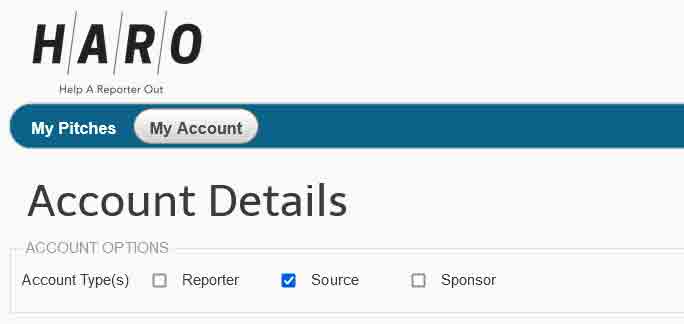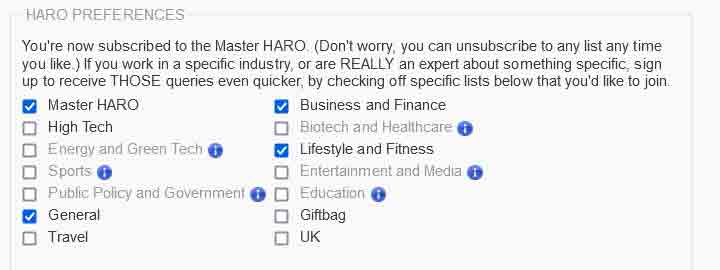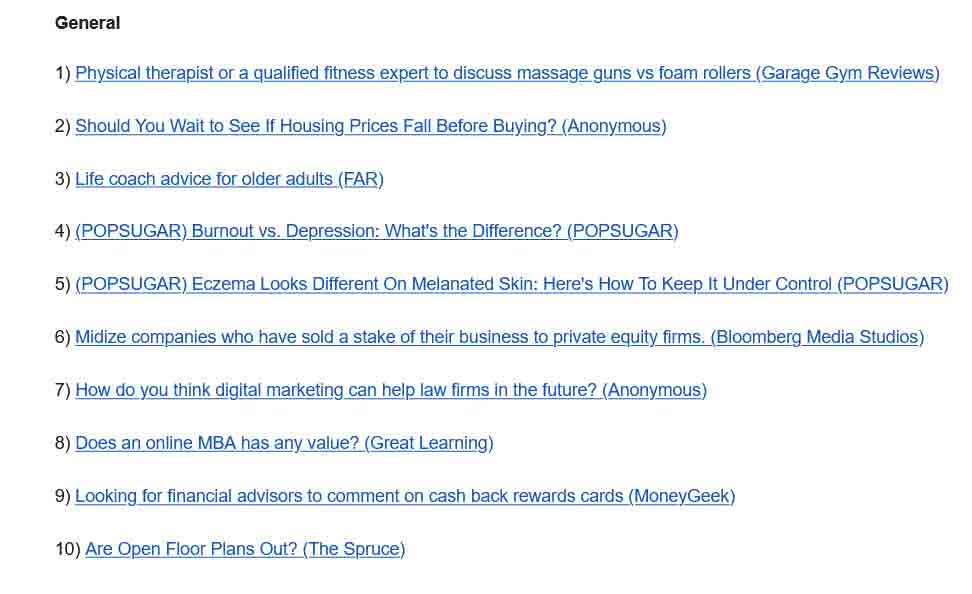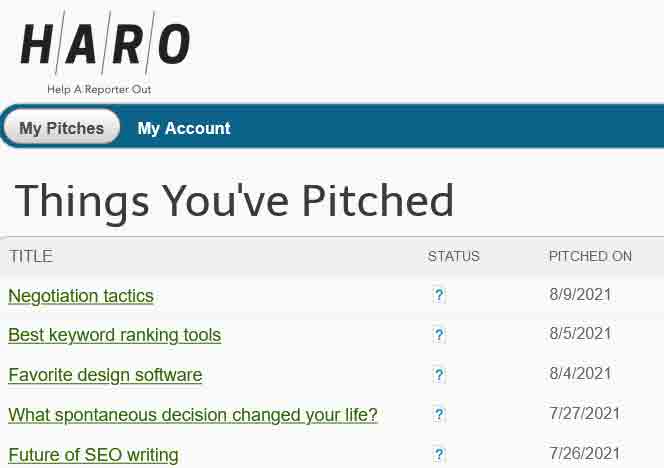One of the most challenging aspects of SEO is link building. If you’ve ever done cold email outreach, you know how tough it is to get someone to give you a backlink. Hey buddy I’ve got this really fantastic blog post, how bout you link to me… It’s a pain in the butt.
Here’s the good news, HARO is one of the best ways to build high-authority links to your website without begging, spamming, or coming up with that stellar “linkable asset”. And the best news, HARO link building is easy.
HARO or Help a Reporter Out connects journalists with sources. It’s a great way to get publicity and backlinks. If you’re in the SEO business, HARO link building is one way that you can get awesome backlinks for yourself and your clients.
I have been using HARO for a few years and have been featured on GoDaddy, UpCity, Lifewire, and many other websites. If you’ve never heard of HARO, I am going to explain what HARO is and how anyone can use it for link building. So let’s get into how to use HARO for backlinks.
What is HARO (Help a Reporter Out)?
In 2008, Peter Shankman created a Facebook group to help reporters find sources for stories. At the time, journalists were having trouble finding experts and sources to interview. His Facebook group was so successful, that he moved it to a mailing list to make it more useful. Today, HARO is one of the largest PR companies of its kind.
In 2010, HARO was acquired by Vocus, Inc, a public relations software company. Then in 2014, Vocus, Inc merged with Cision, Inc. This is the HARO we know today. Although HARO, has a few competitors now, it continues to be a widely used tool journalists use to find experts to quote in their stories.
In the past, businesses had to hire a publicist to get media coverage. Now, anyone can send a pitch to journalists using HARO. It’s completely free for everyone to use. They also have premium accounts for people who are serious about pitching on HARO, but for the average business owner, a free account is sufficient.
That’s a little on the history of HARO, but how does HARO actually work.
How to Use Haro
When I first heard about HARO, I didn’t really get what it was or how to use it. I signed up for an account, but it took me a while to understand how to use it. So if you’re interested in using HARO, the first step is to create an account.
Step 1: Create a HARO account

Creating a HARO account only takes a few minutes. Go to helpareporter.com. Read over the HARO guidelines before you get started. Then click on Sign up and start your account.
Step 2: Select your account type and email list preference.

Once you’re signed up, select your account type. To be a source there are no special requirements, other than that you follow the HARO source guidelines. However, if you want to participate as a journalist, your website must have a Similarweb ranking of 1 million or less.

From your account profile, you can select the type of queries you want to receive. These are my selections. Choose the lists that make the most sense for your business. I typically just read the master list because I am checking HARO for myself and clients. I recommend checking the Master List even if you are subscribed to other lists. Sometimes there’s a query that isn’t in your niche but still makes sense for you to reply to.
You will receive emails three times a day, Monday through Friday at 5:35 a.m., 12:35 p.m., and 5:35 EST with queries from journalists that look something like this.

Step 3: Skim the queries and reply to ones you’re interested in and qualified to answer.
There’s a lot of debate over which HARO pitches to answer. To decide whether or not you are a good source for the journalist, read through the journalist’s requirements before you reply. They usually provide criteria on who they’d like to hear from and also who they don’t want to hear from. Don’t waste a journalist’s time (or yours) by replying to a query you’re not qualified for.
Step 4: Send your pitch.
Follow the journalist’s instructions. A journalist will often tell you how many sentences they are looking for. They might also include specific questions for you to answer. Always keep your email short and to the point. I aim for no more than 3-6 sentences in a pitch. Include your name, title, and a link to your website in your pitch.
If they ask, provide a link to high-quality versions of your headshot. And include a short author bio that they can use in their story.
Then wait. Sometimes, it will be a couple of months before you hear a reply. Not all journalists email you when they use you as a source. You may need to check your backlinks to find out when your responses are used.
HARO Link Building – How I use HARO to get High-Authority Backlinks
When I first started using HARO, I was inconsistent, and my pitches didn’t get used very often. That’s when I read about the Go Hard at HARO challenge published on the Content Factory. Check out Kari’s post. I think it will inspire you to try it yourself.
Now I check HARO consistently every day and send pitches regularly. This is the best way to get results. It does take time to write a quality pitch that a journalist will actually use, but it’s still a whole lot more effective than email outreach and link begging. Here are my best tips for getting backlinks from HARO.
Set an alarm to check for HARO emails
HARO sends pitches three times a day at 5:35 a.m., 12:35 p.m., and 5:35 EST. Set an alarm to go off 3 times a day to remind you to check your email.
When it comes to getting backlinks, the early bird really does get the worm. Keep in mind that there HARO has close to a million users. That means these journalists may get hundreds of responses to sort through. The odds of them scrolling through all of them are slim, so get your pitch in early.
Check all three emails every day.
I recommend you check all three emails every day. The morning HARO emails are often the most important queries to reply to. You might be tempted to skip the later emails. While they generally include the same queries that were sent in the morning, there are often different queries sent later in the day. Don’t miss an opportunity by skipping one. Some of my best pitches were replies to evening queries.
Pitch to as many HARO queries as possible.
I’ve read other marketers suggest that you should only reply to one or two HARO queries a day or that you should just focus on the ones you can answer quickly and easily. I disagree. Just like sales, pitching to HARO is often a numbers game. The more you pitch, the higher your chances are of getting your pitch published. Not to mention, practice makes perfect. The more you make HARO a habit, the better you’ll get at it. This doesn’t mean you should answer questions you’re not an expert on, but if you see a good query pitch it.
How to write better HARO pitches that reporters want to use
Skip the long intros and bragging.
There are a lot of opinions out there on how to write an intro for HARO. Some people say that you should name-drop other media outlets where you have been featured. Others say to keep your intro short and get to the point. I agree with this approach.
I don’t name-drop in my intros. I only mention my background and history if it’s relevant. The reporter is looking for great quotes, not an ego trip. In my opinion, your quote should sell itself. I usually write a short intro about myself explaining that I own a digital marketing agency in Albuquerque.
Make your pitch unique and interesting.
If you’re not bringing something new to the table, there is no reason to pitch a reporter. They can simply Google common tips and advice. They are looking for expert insight or something of value to add to their story. If you can’t come up with it, pass on it. Even if you can articulate common knowledge in a more interesting way, your pitch will stand out.
Take your time writing a pitch
One of the most frustrating aspects of pitching to HARO is that most of the time your pitches won’t get used. That doesn’t mean you should rush through them. When I see a query I am really interested in, I open a new document and start writing my pitch. I never send an email directly from my email. By putting it in a separate document, I can work on and revise my pitch. I have spent as long as an hour writing a HARO pitch before. While that may seem like a lot of time when you consider the cost of acquiring a backlink, it’s really not.
Little secret: Use an AI writing tool
When I first heard about AI writing tools, I thought I would never use one. However, one day I decided to try it. I am glad that I did. When I get stuck on how to word something, I copy and paste what I have written into my Go Copy writing assistant. Sometimes it helps and sometimes it doesn’t. But if you write a lot of pitches, having an AI assistant can help you to write better pitches and respond faster.
Use Grammarly
This might seem like a no-brainer, but you would be surprised at how many people don’t proofread their emails. Run every HARO query through Grammarly. Then read through it again to make sure you don’t have any grammar or spelling errors.
Condense your pitch, the shorter the better.
Most of the time, you should be able to write a sentence or two that answers the journalist’s question. However, if the question is more complicated, you can write more. The reporter isn’t looking for you to write the story for them though. They are looking for quotes that can be used in their article. Keep this in mind when you craft your pitch.
Practice, practice, practice
Just like anything in life, the more you practice something, the better you get at it. Every day, try to improve your pitches. Compare the pitches that are published with the ones that are not. Make a note of any patterns. For example, when I pitch to SEO topic queries, my quotes get used more often. My HARO pitches, and writing in general, have improved over the last two years simply because I practice writing regularly.
Track your progress
The old saying, “what gets measured, gets improved,” is true. Keep track of how many pitches you send and how many get published. This will give you a clear idea of your ROI on your efforts. You can check the number of pitches and the response to them by going to HARO. Then click on pitches.

Pay attention to reporter feedback.
I was quoted in the pitch “Favorite design software”. They even called me for an interview. Sometimes the reporter will provide feedback on the status of your pitch, but most of the time they don’t. Still, check your HARO dashboard periodically. You can see sometimes the reporter will give you feedback. Even when it’s negative feedback, it can help you to improve your pitch.

Effective HARO Link Building Requires Time, Consistency, and Commitment
At first, I felt like HARO was using up a lot of my time, but I’m glad that I stuck with it. I wrote pitches, they didn’t get used. I wrote more, and still nothing. If you go into this understanding that most of your pitches won’t get used, you’ll be less discouraged. Don’t expect every pitch to work out, just keep plugging away at it.
HARO is an amazing opportunity to build relationships with other digital marketers and boost your website’s traffic. Some of my best backlinks and relationships with other digital marketers have come from HARO. Once they use your pitch, they may invite you to write guest posts or contribute to their blog. Consider HARO an investment in your link-building strategy, and put in the time, consistency, and commitment. This is the best way to get better at HARO link building.

I am Patty Malowney, the creator of Badass Web Goddess. I am an Albuquerque SEO and digital marketing consultant. I started my first internet business in 2004 with a $40 garage sale computer and a whole lot of determination. I sold my first website, JustMommies.com to the dating company eHarmony.com in 2008. My website was acquired by another company where I worked as a consultant and editor until July, 2019.
After encouragement from friends and family, I decided to branch out on my own and start my own consulting business. I offer advice and services to local businesses on how they can rank better in Google.
In addition to running Badass Web Goddess, I am an avid blogger. I run several blogs including my internet marketing blog here at Badass Web Goddess. If you love my blog, Follow Me on Facebook or Twitter!





